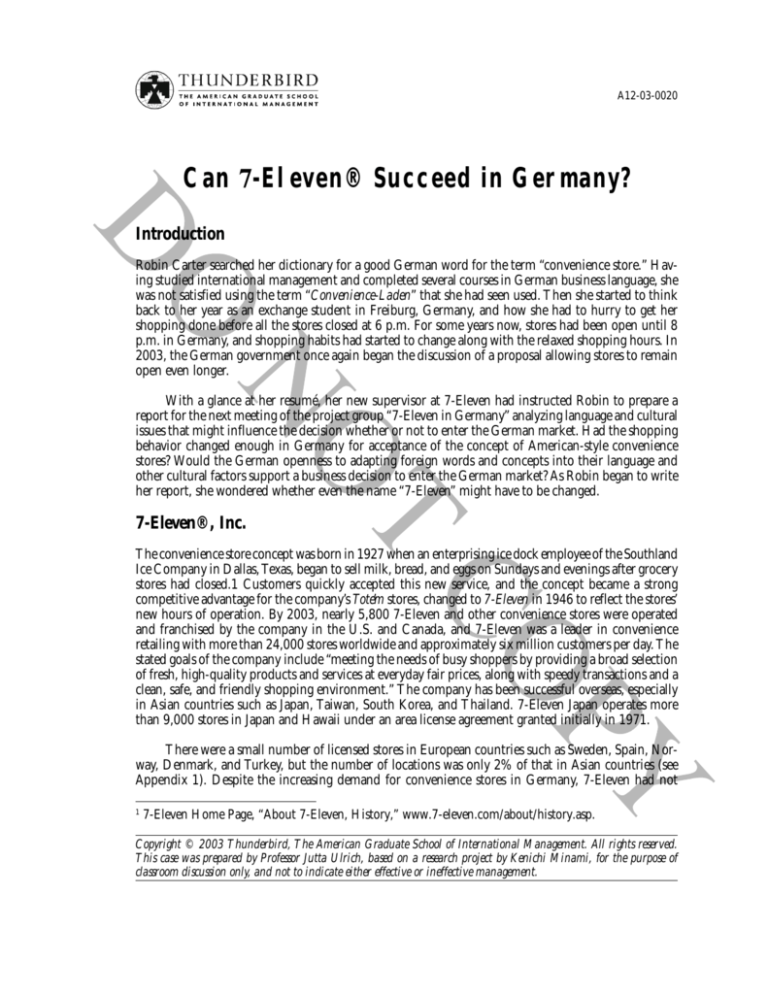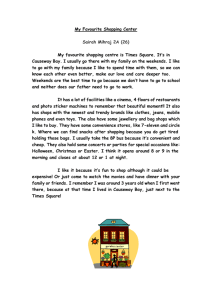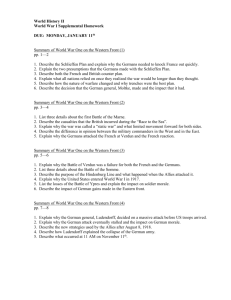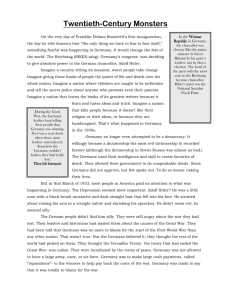
A12-03-0020
Can 7-Eleven® Succeed in Germany?
Introduction
Robin Carter searched her dictionary for a good German word for the term “convenience store.” Having studied international management and completed several courses in German business language, she
was not satisfied using the term “Convenience-Laden” that she had seen used. Then she started to think
back to her year as an exchange student in Freiburg, Germany, and how she had to hurry to get her
shopping done before all the stores closed at 6 p.m. For some years now, stores had been open until 8
p.m. in Germany, and shopping habits had started to change along with the relaxed shopping hours. In
2003, the German government once again began the discussion of a proposal allowing stores to remain
open even longer.
With a glance at her resumé, her new supervisor at 7-Eleven had instructed Robin to prepare a
report for the next meeting of the project group “7-Eleven in Germany” analyzing language and cultural
issues that might influence the decision whether or not to enter the German market. Had the shopping
behavior changed enough in Germany for acceptance of the concept of American-style convenience
stores? Would the German openness to adapting foreign words and concepts into their language and
other cultural factors support a business decision to enter the German market? As Robin began to write
her report, she wondered whether even the name “7-Eleven” might have to be changed.
7-Eleven®, Inc.
The convenience store concept was born in 1927 when an enterprising ice dock employee of the Southland
Ice Company in Dallas, Texas, began to sell milk, bread, and eggs on Sundays and evenings after grocery
stores had closed.1 Customers quickly accepted this new service, and the concept became a strong
competitive advantage for the company’s Tote’m stores, changed to 7-Eleven in 1946 to reflect the stores’
new hours of operation. By 2003, nearly 5,800 7-Eleven and other convenience stores were operated
and franchised by the company in the U.S. and Canada, and 7-Eleven was a leader in convenience
retailing with more than 24,000 stores worldwide and approximately six million customers per day. The
stated goals of the company include “meeting the needs of busy shoppers by providing a broad selection
of fresh, high-quality products and services at everyday fair prices, along with speedy transactions and a
clean, safe, and friendly shopping environment.” The company has been successful overseas, especially
in Asian countries such as Japan, Taiwan, South Korea, and Thailand. 7-Eleven Japan operates more
than 9,000 stores in Japan and Hawaii under an area license agreement granted initially in 1971.
There were a small number of licensed stores in European countries such as Sweden, Spain, Norway, Denmark, and Turkey, but the number of locations was only 2% of that in Asian countries (see
Appendix 1). Despite the increasing demand for convenience stores in Germany, 7-Eleven had not
1
7-Eleven Home Page, “About 7-Eleven, History,” www.7-eleven.com/about/history.asp.
Copyright © 2003 Thunderbird, The American Graduate School of International Management. All rights reserved.
This case was prepared by Professor Jutta Ulrich, based on a research project by Kenichi Minami, for the purpose of
classroom discussion only, and not to indicate either effective or ineffective management.
entered the German convenience retailing market before 2003. Competition was intense, margins slim,
and the hours of store operation limited by law to daytime hours, Monday through Saturday. With
continuing changes in the retail environment, however, 7-Eleven might want to reassess its opportunities for entering the German market.
The Food Retailing Environment in Germany
With 82 million people and the largest economy in Europe, Germany was the leading food and beverage market in Europe. Products from within Germany and other EU countries dominated the shelves of
stores, mainly due to the duty-free movements of goods and geographical advantages among the EU
countries.2 Although there were stringent food laws and regulations with regard to packaging and labeling, there were excellent opportunities for entry by companies from non-EU countries, since the German government actively encouraged foreign investment in Germany.3 International firms must, however, take into consideration all regulations regarding advertising, packaging, and store operations since
German law treats international and German firms alike.
In addition, retailers were affected by local labor laws. Labor costs were high, due to the relatively
high standard of living and also mandatory benefits. Part-time employment was becoming more widespread, but pressure was high on employers to provide full-time positions with benefits. All employers
in Germany paid 50% of contributions for health insurance, unemployment insurance, and retirement
benefits. Also, the length of the typical work week at 37-39 hours and the annual paid vacation time of
4-6 weeks tended to be generous towards employees, along with regulations for family leave. In addition, Germany’s laws regarding codetermination required a higher degree of employee involvement in
the running of a business, and letting employees go on short notice became very difficult after a brief
period of employment. Furthermore, land and building costs were high, and due to the unstructured
layout of many German towns, including many narrow streets, sufficient parking space could become
an issue.
Competition
Germany’s food and beverage retailing sector was highly competitive, existing on slim margins and
undergoing considerable concentration. In addition to roughly 25,000 discount stores, supermarkets,
and hypermarkets, there were more than 40,000 small and medium-sized grocery stores at the beginning of 2002. Their share of the revenues was only 14%, with about 10 large retailers accounting for
80% of the turnover in foods and beverages, among them Rewe, Aldi, Edeka, Tengelmann, and the
German-Swiss enterprise Metro.4 (See Table 1 for revenue data of the largest grocery retailers in Germany.) Each of these leading retail groups also had a different business structure as well as purchasing
and distribution system. Many owned several retail chains, often with various types of retail formats,
such as large supermarkets, discounters, and small neighborhood stores. Edeka, for example, operated
the Edeka, E-Active, and Condi supermarkets, the discounters Preisgut, Diska, and Treff, the hypermarkets
Marktkauf, Dixi, and E-center, as well as several cash-and-carry markets. Since 1997, Wal-Mart had
been acquiring and remodeling department stores in Germany, trying to import its philosophy of low
prices and friendly service. Losses mounted to above $200 million annually as Wal-Mart underestimated the fierce competition in the German retailing industry, the zoning restrictions, and various
limitations on pricing and advertising, prohibiting, for example, resale of products below cost.
2
U.S. Department of Agriculture Foreign Agriculture Service, “Germany: Retail Food Sector 2000,”
www.fas.usda.gov/gainfiles/200003/25647196.pdf.
3
Country Watch, Germany, www.countrywatch.com/cw_country.asp?vCOUNTRY=65.
4
Corporate Information—What you need to know, www.corporateinformation.com /desector/Retail.html.
2
A12-03-0020
Table 1
The Largest Retailers in Germany
(Sales in Germany in billion Euro)
Metro
Rewe
Edeka/AVA
Aldi
Schwarz
Tengelmann
Karstadt
Lekkerland-Tobaccoland
SPAR
Schlecker
Globus
Dohle
Wal-Mart
Food Sales
14.4
19.6
20.9
20.3
13.8
7.8
0.9
6.9
7.0
5.0
1.9
2.4
1.4
Total Sales
32.0
28.6
25.2
25.0
17.2
12.5
8.5
8.2
7.5
5.3
3.4
2.9
2.9
Source: Globus Infografik (2003): Die Riesen im
Lebensmitteleinzelhandel, Globus publication Ea-8397.
Convenience Stores in Germany
Types of Stores
Convenience stores were among the fastest growing retail formats in Germany, with the expectation
that their sales would rise significantly, particularly as their product presentations were updated and
enlarged and the variety of products offered was expanded. In addition to nonfood items, the most
popular items at convenience stores were beverages, including fruit juice and fruit drinks, soft drinks,
beer, and wine, along with pastries, candy, and snacks. Products sold in these stores typically were priced
30% to 70% higher than in more conventional stores. The more-than-80,000 convenience stores could
be broken down into four types: gas stations, train stations, kiosks, and bakeries. The latter provided
many snack foods and other food and beverage items in addition to bread, pastries, and sandwiches that
made Germans the European champions in bread consumption with a per capita consumption of more
than 180 pounds annually.5 Bakeries had such a long tradition in Germany that many Germans would
not automatically classify them as convenience stores, but simply as bakeries, typically with average
prices.
Hours of Operation
Shopping hours in Germany were among the most restricted in Europe since the 1950s. Germany’s
draconian law governing retailing hours, das Ladenschlussgesetz, ensured that stores remained closed
after 6 p.m. on weekdays, after 2 p.m. on Saturday, and altogether on Sunday, with the exception of
outlets such as gas station and train station shops, which provided necessary items to travelers. Stores
were allowed to remain open two hours longer on the first Saturday of every month, on a day called der
lange Samstag, that is, the long Saturday. In June 1996, the German Parliament gave in to pressure from
both business and consumers and eased the Ladenschlussgesetz. Shops were allowed to remain open until
8 p.m. on Thursday and eventually on all weekdays, and until 4 p.m. on Saturday. In the weeks leading
up to Christmas, shops could remain open until 6 p.m. on Saturday. However, while it made sense for
businesses in major cities like Berlin to extend hours, many small shops in towns and villages found that
longer opening hours did not necessarily mean more turnover and went back to the old opening hours—
Thursday till 8 p.m. but 6:30 p.m. on Monday, Tuesday, Wednesday, and Friday. Some gas stations
5
“Mischbrot bleibt Nummer eins,” (21 March 2003) www.butterbrot.info.
A12-03-0020
3
remained open all night and also on Sunday and were allowed to sell food and other items. In January
2003, the German government entered a new round of discussions, possibly allowing shops to remain
open longer, excluding only Sundays and holidays. As of June 2003, the new regulations permitted
longer shopping hours on Saturdays. Stores could remain open until 8 p.m. Monday through Saturday.
Consumer Shopping Behavior in Germany
There were a great variety of shops in Germany. For groceries, there were many small and medium-sized
stores (rather than two or three large supermarkets) in residential neighborhoods as well as in central
shopping streets known for their density of shops. There were many specialty stores for baked goods, for
meat products, cheese and dairy, health food, spirits, candy and chocolate, tobacco and newspapers. In
addition, large department stores, particularly in big cities, turned an entire floor of the building into a
grocery store with a restaurant and specialty foods. On the outskirts of towns, shopping centers with
hypermarkets, furniture, and do-it-yourself stores, and other large markets sprang up and gained popularity due to lower prices, location, parking spaces, and accessibility to many types of products.
In town, many people went to train stations (long-distance stations comparable to Grand Central
Station in New York, but also subway and commuter train stations) just in order to frequent the stores,
even when they were not traveling anywhere. Since train stations were often located in the center of
town, they were accessible by public transportation and on foot, both of which were important means
of transportation in Germany. Many Germans used city trains and subways on a daily basis and bought
needed items on the way home. Cars and their drivers also frequented train stations, but parking could
be difficult, sending drivers routinely to gas stations to make purchases of convenience items. Freestanding kiosks and gas stations became the predominant convenience stores in Germany, offering beer,
snacks, sandwiches, and fresh-cut flowers. Some gas stations were open on Sundays and/or during the
night. Sales of products other than gas were supposed to be limited to “necessities for the journey,” just
as in train stations; however, no questions were asked.
Despite the loosening of restrictions, some shops still closed at 6 p.m., with more and more
remaining open until 8 p.m. During the week, shopping could still be a hurried affair squeezed into the
time between leaving work and stores closing. On Saturdays, shopping became more of an event and a
family outing. Families drove to large hypermarkets further away, but offering more parking along with
a variety of shops and lunch opportunities. Some stores, and even whole towns, pushed for a loosening
of the restrictions on shopping hours. When a regional festival was planned (a frequent event in small
German towns), the city might want to allow its merchants to keep the stores open for visitors. Also,
supermarkets and department stores were finding that consumers had to be turned away on Saturdays at
4 p.m. as Germans were getting used to the somewhat longer hours and were learning about shopping
culture from their many visits to the United States and other countries.
Demographic data showed that there was a large number of single-person households (37% of all
households in 2001) and an increasing number of women entering the workforce in Germany. In 2000,
nearly 58% of working age women were employed, compared with 51% in West-Germany in 1974.6
The percentage in the former East Germany had been higher but decreased to the national average. The
demographics significantly impacted the food consumption trend and average household income. The
growing number of single-person households and more working women resulted in less time available
for preparing meals, which increased the frequency of dining out and consumption of convenience
foods, easy-to-prepare meals, and snacks.
Germans, like many Europeans, valued quality and freshness. Other aspects shaping the buying
decision could include exotic origin, references to a natural lifestyle, and environmental concerns. However, more and more, price became the determining factor. For high-end items, buyers looked at the
6
4
“Frau und Arbeit,” 13 March 2000, GLOBUS Infografik GmbH, Ka-6187.
A12-03-0020
Preis-Leistungsverhältnis, the relationship of price to quality, or performance and value, but price was
clearly the decision criterion for routine items. Traditionally, Germans made frequent trips to the store,
partially due to small storage spaces and small refrigerators, and also the desire to buy fresh bread
products, meat, and produce. Specialty stores were still popular for high-end products because of the
value placed on expert advice and the general notion that quality is directly associated with specialization and thorough training in one’s field. With increasing frequency, however, Germans bought in bulk
at less-expensive outlets, such as discounters (37% of sales) and hypermarkets (42% of sales)7, often
located on the outskirts of towns, and more Germans had a freezer in addition to their refrigerator.
An interesting phenomenon occurred along the borders with central-eastern European countries,
including Poland and the Czech Republic. Germans were taking their business to grocery stores, hairdressers, and other retail outlets across the border where prices were lower. On the German side, many
businesses had to close shop, as Germans openly and consciously bought their necessities in the cheaper
market without regard to national borders. With the entry of these countries to the EU, additional
changes were expected to occur.
Culture and Values
German society placed value on the well-being of the whole community. The government, along with
churches, unions, and other organizations, has taken an active role in shaping a lifestyle that allows free
time, time for family activities and for the pursuit of noncommercial activities, including religion and
hobbies, contemplation, and general relaxation, known as Freizeit und Erholung. Critics charged that
employees in the food service and entertainment industries, in the medical field and the police, fire, or
transportation departments routinely worked on weekends and during the night. Nevertheless, some
politicians and union representatives held the line as they considered work on Sunday inappropriate for
a civilized society.
The values embedded in Germany’s social market economy found much support among the people,
the government, and the unions, which meant that employee protection, a high quality of life, and a
sense of fairness and equality pervaded German thought. In addition, Germans tended to change slowly.
They were risk averse and they liked structure and avoided uncertainty. In other words, they liked to
plan ahead, make a decision, and stick to it.
More and more Germans spoke English and felt comfortable using the English language. News
media routinely introduced foreign language words. This was true especially for English words, at first
explaining the meaning, then trying a German translation, and eventually using the original Englishlanguage word. Nearly all children began studying the English language in grade school, and many
continued to study English all through high school. In business, English had become a lingua franca,
and television broadcast numerous American shows, usually dubbed into German with a generous
sprinkling of English words.
U.S. Suppliers and Products in Germany
Business people in Germany at times perceived U.S. suppliers as being unreliable. They considered
U.S.-Americans superficial and too focused on the short term. Thus, many U.S. companies were not
seen as long-term players in the market and were not viewed as likely to provide adequate after-sales
support. A commonly voiced complaint in the German business community was about the “American
penchant for being here today and gone tomorrow.”8
On the other hand, breaking into the competitive German network of retailers and suppliers
might be even more difficult. Success in Japan—clearly the most successful international market for 77
8
U.S. Department of Agriculture, op.cit.
“Germany—Food Market Report,” 1996, Tradeport, www.tradeport.org/ts/countries/germany/fdmrkt.html.
A12-03-0020
5
Eleven—was the result of achieving integration into the Japanese retailing environment. 7-Eleven Japan
established a strong supply chain with domestic suppliers, and not many people realized that the company originated in the U.S. The success of 7-Eleven in Japan was also due to the first-mover advantage
back in 1971 and implementation of a POS (Point of Sales) system and alliances with strong local
distribution channels. All played important roles. Although some buying habits of Germans were similar to those of the Japanese (more frequent purchases of fresh foods because of smaller kitchens and
small refrigerators, patronage of specialty shops), success in the German market was not certain. The
restraints of the market and the power of the dominant German competitors create substantial obstacles
for 7-Eleven in Germany.
Retailers in Germany usually did not import their own products, but used specialized importers
with in-depth knowledge of the market and distribution channels, many with their own nationwide
sales network and distribution systems. There were several large wholesalers that supplied food and
nonfood products to these convenience stores, among them Lekkerland, Spar Group, and Tengelmann.
The leading supplier was Lekkerland–Germany, which more than doubled its sales after acquiring
Tobaccoland in 1999. Lekkerland supplied an estimated 70,000 customers, including 14,000 kiosks,
13,000 gas station shops, 9,000 beverage stores, and 8,000 bakeries.9
Contrary to the perception towards the U.S. suppliers, German trade and consumer interest in
U.S. food and beverage products had been increasingly positive. For many years, the favorable USD/
Euro (formerly USD/DM) exchange rate and resultant strong growth in German tourism to the United
States appeared to have positively influenced German consumers’ attitudes and their propensity to
purchase U.S. consumer products. A growing number of restaurants, food service, and retail stores in
Germany made USA, California, or other U.S. state/region promotions a standard component of their
annual promotional regimen. An increasing number of franchised U.S.-based restaurants, USA-food
corners in department stores and supermarkets, and special USA stores and mail-order businesses also
inspired German consumers to try new U.S. products or to purchase foods and beverages. The generous
and even super-sized portions and drinks so typical at fast-food outlets in the United States were,
however, not common in Germany but might be received well if the price were right.
Conclusion
With the introduction of the Euro as the common currency in most member states of the European
Union, many prices went up, further curtailing already low consumer spending. In her study of recent
news publications, Robin Carter was looking for indications that the retailing environment in Germany
might change, presenting new opportunities for the convenience store industry. Competition was fierce,
but 7-Eleven already had a presence in some European countries, and the company had proven its
competitiveness in numerous international markets. Also, the Euro had made gains against the dollar,
and the recent lengthening of the Saturday shopping hours was a good sign.
9
“Daten, Zahlen, Fakten” (22 March 2003), Lekkerland-Tobaccoland GmbH & Co. KG Home Page,
http://www.lekkerland.de/lt/de/unternehmen/daten_zahlen_faktenKopie_von _datenzahlen.html.
6
A12-03-0020
Appendix 1
International Licensing of 7-Eleven Stores
Territory
United States (U.S. Licensees)
Canada*
Mexico
Japan
Australia
Sweden
Taiwan
China (Hong Kong, Shenzhen, and Guangzhou)
Singapore
Philippines
Malaysia
Norway
Puerto Rico
Guam
South Korea
Thailand
Turkey
Hawaii
Denmark
First Store Opened
1968
1969
1971
1971
1977
1978
1980
1981, 1992, and
1996, respectively
1983
1984
1984
1986
1987
1987
1989
1989
1989
1989
1993
No. of Locations
432
496
366
9,447
284
70
3,187
604
174
168
215
71
13
8
1,401
2,042
18
55
43
*A Wholly Owned Subsidiary of 7-Eleven®, Inc.
Source: 7-Eleven Home Page, International Licensing, http://www.7-Eleven.com/about/globalsites.asp, March 2003.
A12-03-0020
7






